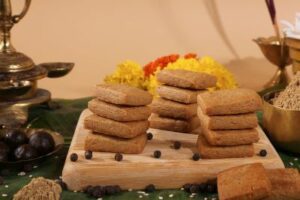A staple in most Tamil-speaking households, the Deepavali marundhu, is the first food that is consumed on the day of Deepavali, before the deluge of other delicacies.

The marandhu is believed to be a powerful ammo to prepare the gut for the deluge of Deepavali delicacies. (Supplied)
The day of Deepavali was the one that always jostled for my attention, among all the other festive days. My brother and I would wake up in a sleep-induced haze, drowsily walk to the puja room and perch ourselves on a wooden plank. Our mother, or sometimes grandmother, would then bring a steel bowl filled with warm gingelly oil and smear the oil on our hands, face and scalp, and offer a brief but gentle massage before it was time to head for Ganga snanam (the quintessential oil bath).
This Deepavali morning ritual was elaborate. After the oil bath, we would await the grand display of breakfast which included laddoos, murukku, mixture, and other Deepavali fare, alongside steaming idlis and coconut chutney.
But, it was only after the mandatory consumption of a dark olive-green-hued marble-sized ball called Deepavali legiyam or marundhu that everything else could be devoured. A staple in most Tamil-speaking households, the marundhu, literally translated as medicine, is the first food that is partaken on the day of Deepavali.
The marandhu is believed to be a powerful ammo to prepare the gut for the deluge of Deepavali delicacies. Precisely why it was the first item that used to be prepared in the home of Shanthi Ramachandran, a resident of KK Nagar in Chennai. Marundhu would find itself in the making to kickstart the festivities, even before the kitchen got aromatic with the scents of Deepavali delights.

Shantha Ramachandran is a retired banker, who has a following of more than 50K on Instagram. (Supplied)
But Ramachandran never considered it as a marundhu. Instead, she would eat it like halwa as her amma made it with limited medicinal ingredients, and used more jaggery and ghee. “Amma used to warn us saying, it is marundhu and has to be consumed in less quantity. Eating too much ginger can cause more harm than do good, she would tell us,” reminisces the retired banker.
At baker Aarthi Santhanam’s home too, Deepavali marundhu was a mainstay. Santhanam grew up initially in a joint family set-up where festivals were celebrated with fervour and feast. As years passed, owing to her father’s job transfer, she moved away from her relatives, but her love for marandhu stayed as a constant. And eventually, it translated into Deepavali treats at her baking venture Bakespeare Tales in 2019.
“I was working on infusing traditional flavours and recipes in modern cookies. Indian cooking involves a lot of spices. Usually, cookies have cumin, carom, pepper or ginger,” she shares. It was during one of her trials during Deepavali 2019 that she had her Eureka moment.
The story is not different at Bengaluru-based home chef and digital content creator Priya Iyer’s home. Only when the fragrance of the many spices used in the legiyam permeates their house, does she start feeling Deepavali-ready! “I have fond memories of amma making the legiyam a day or two before Deepavali. Only after this she’d prepare other bakshanams,” she recalls.
Priya vehemently disliked marandhu while growing up. But consuming a bite-sized portion of this spicy and potent mix was a must, before having an oil bath, and changing into new clothes, and breakfasting on Deepavali, she adds.
At Ramachandran’s amma’s place in Tirunelveli, ground ginger, cumin, a pinch of coriander seeds, ghee and sesame oil was used to prepare the legiyam. It was only after her marriage that she discovered that marundhu is made using a lot of country medicinal items. She became aware of its curative quality for gut health and digestion.
“Unlike my amma, my mother-in-law, who was from Tanjore, used to get 15-20 medicinal ingredients from the naatu marundu kadai (country medicine shop). She would dry them in the sun, and roast them individually in slow fire. Then, using a grinding stone, it would be powdered. After this process, she would add jaggery, ghee and honey, which would taste exactly like legiyam, and not like my amma’s ginger halwa,” laughs Ramachandran.
This was also the reason Santhanam decided to flavour her cookies with marundhu. The combination of jaggery, ghee, pepper and honey seemed ideal to introduce tradition in small modern bites. It was an instant hit, and has been a staple on Santhanam’s Deepavali menu. While she ensures other flavours are available for customers, her legiyam minis have given Chennai’s palate a twist with reverence for tradition.

Aarthi Santhanam’s legiyam minis have given Chennai’s palate a twist with reverence for tradition. (Supplied)
“Possibilities are endless,” offers Santhanam.
Unlike Ramachandran and Santhanam, Iyer grew up in Gujarat, where it wasn’t easy to procure spices like thippili (long pepper) and sittharatthai (greater galangal) required for the legiyam. There was no online shopping and her amma would painstakingly go around various Ayurveda stores in their vicinity to procure the spices. “I loved the scent of these lesser-known spices then, and I still do,” she adds.
Sometimes, when Iyer’s relatives visited them from South India, they would bring store-bought legiyam. “But it would be quite hard, spicy, and somehow less flavourful. It was not the gooey, delicious, perfectly balanced confection that well-made Deepavali legiyam is,” she shares.
Ramachandran continues to follow the tradition set by her amma. With her mother-in-law’s recipe, legiyam is made first. “The only difference is I use the readymade powder made at home by my appalam-selling mama. It makes my job of making this easier as well,” chips in Ramachandran, who has a following of more than 50K on Instagram.
Santhanam had no such luck with the generational recipe. Following a few discussions with her mother about the ingredients and her familiarity with flavours, she let the universe conspire. And it did. The cookies are now her Deepavali bestsellers. “A chunk of my clients order a kilo or two of this every year,” she informs.
In recent times, marandhu podi is not made at home, Ramachandran rues. “Nowadays, some people follow the same method to make the powder at home and sell it. “It saves a lot of time; I have to only add jaggery syrup and ghee into the powder,” she elaborates.
Between the flavours of her amma and her mother-in-law, Ramachandran prefers her amma’s inji marundhu while her husband prefers his mother’s Deepavali legiyam.
But Ramachandran tweaked the recipe when she needed this in large quantities and the powder was available in limited quantity. “I have tried to make a fusion recipe of my amma’s and mother-in-law’s procedures which turned out well. When I have extra powder, I mix a bit of it along with turmeric powder in hot milk with palm jaggery. It works as a medicine to cure cough, cold and sore throat,” she adds.
Iyer follows the recipe passed on to her by her grandmother. “My grandmother’s recipe has over 12 different types of spices. I don’t skip any of them and I patiently hunt down each one,” she informs. Without tampering with the original, Iyer has merely translated her grandmother’s mostly eyeballed measurements, ‘a
little bit of this and a wee bit of that’, into precise cups, teaspoons and tablespoons.
After the success of her legiyam cookies, Santhanam attempted a legiyam-infused cake. But, she was convinced that the marundhu cookies had the edge of exclusivity. No experiments since then.
The making of legiyam, however, is not restricted to the festive season in these homes. Ramachandran ensures she makes it round the year as it “acts as a good medicine for digestion even on normal days.” She even prepared it as a postpartum medicine for her daughter and daughter-in-law.
View this post on Instagram
A post shared by The Girl Next Door (Priya) (@the_girl_next_door_diaries)
Iyer too prepares a batch whenever the family’s digestion or immunity appears weak. Santhaman nods in agreement with this sentiment. “Everybody in the house loves it. And apart from the taste, it has medicinal benefits, which aids in our fitness,” she says.
The last word rests with Iyer who cannot imagine Deepavali without traditions. “Legiyam is my connection with my roots, my way of passing on my legacy to my daughter,” she signs off.

Jul 26, 2024

Jul 26, 2024

Jul 24, 2024

Jul 24, 2024

Jul 19, 2024

Jul 18, 2024